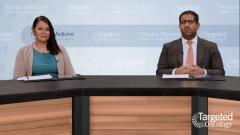
Overview of the NSCLC Landscape, Prognosis, and Biomarker-Driven Treatments
A comprehensive overview of the current landscape of non-small cell lung cancer (NSCLC), highlighting the impact of biomarkers on treatment selection.
Episodes in this series

Joshua Sabari: Hello and thank you for joining this targeted oncology presentation titled CEACAM5, an Emerging Therapeutic Target in Non-small Cell Lung Cancer. I'm Dr. Joshua Sabari, a thoracic medical oncologist at NYU Langone Health Perlmutter Cancer Center in New York. Joining me today is my esteemed colleague, Dr. Florez. I would like to invite Dr. Florez to introduce herself.
Narjust Florez: Hi, everyone. My name is Dr. Narjust Florez and a thoracic medical oncologist at Dana Farber. Also an assistant professor of medicine at Harvard Medical School. Thank you much for joining us. In today's precision medicine and oncology discussion, we will talk about the role of CEACAM5 and the growth and progression of non-small cell lung cancer. And review the mechanism of action, current safety and efficacy data from recent trials surrounding CEACAM5 therapies for advanced non-small cell lung cancer. So let's begin.
Joshua Sabari: Dr. Florez, tell me a little about the standard of care before we get going in non-small cell lung cancer. How are you looking at patients in the frontline setting?
Narjust Florez: Well, before I get there, let's talk about what is the landscape on non-small cell lung cancer. Today, we're going to be focusing in non-small cell which is 85% on all lung cancers. Unfortunately, the five-year survival for the latest data is still 25% for these patients. Luckily, the mortality of lung cancer has significantly declined due to the development of biomarkers and new therapies. This is the fastest decline of mortality tends to new therapies in the last 10 years. As we talk about first line therapy, lung cancer is no longer one disease. We have non-small cell lung cancer that gets divided in Adenocarcinoma and squamous and then we go to the molecular level now. What are the different biomarkers? Where are the different mutations? Each one of these lung cancers will behave differently based on the genomic profile. Not only the main mutation, but also the co-mutations. What we used to see as one disease is no longer one disease. It is composed of heterogeneous groups or subtypes of lung cancer, that require individualized and personalized care, to get that survival benefit that we continue to praise about it. And we continue to work to increase every and every year we need more lung cancer survivors.
Joshua Sabari: I couldn't agree more. If you go back and look just 10, 15 years ago, really, all we had was chemotherapy, and it was based on histology. If you were adenocarcinoma, you got a platinum based regimen with pemetrexed. And if you had a squamous cell histology, you received a platinum doublet with a taxane. That was really our selective factor. As you mentioned, Dr. Florez, outcomes were dismal for patients, median, five-year overall survival, 16 months. Now that we have biomarkers it's really critical to test. Some of the important biomarkers to think about you hit the nail on the head are the driver alteration. Doing broad panel, next generation sequencing. And we've made tremendous strides in the targeted therapy, precision medicine field, multiple FDA approvals of therapies that not only improve patient's overall survival, but allow people to live better and live longer with good quality of life. So understanding what biomarker your patient has is critical for match targeted therapy. And that's the classic EGFR ALK, ROS1, RET space. Now, there are other biomarkers that are not mutations or driver alterations, such as protein expression right on the surface of cancer cells, things like PD-L1 or programmed death-ligand one. And that has become critical in how we think about the utilization of immunotherapy. Just quickly before I go on to immunotherapy. I always think about this what if you have a patient with a high PD-L1 Dr. Florez 100%, but also an EGFR mutation? How are you thinking about that?
Narjust Florez: Well, that's a very good question, because the PD-L1 always going to come before the genomic testing comes. But we cannot go and dance salsa for a PD-L1 100%, without having the genomic results. When the PD-L1 is 100% is a good thing. But we need to wait for molecular target because how we're going to treat the patients. And based on that molecular information. I told my ladies, as I see mostly women with lung cancer is we need to wait for all the pieces of the wedding gown. You're not going to get married with a first wedding gown that you try. You need to try several. That's what next gen sequencing is. Allows my patient to get that tailored wedding gown that allows them to live better and live longer. We can not only get inside about PD-L1. We need to wait for biomarkers to come back.
Joshua Sabari: I couldn't agree more. It's hard to sometimes sit on our hands. But really the PD-L1 expression alone should not drive your therapy really agree you need to wait for the molecular testing.







































